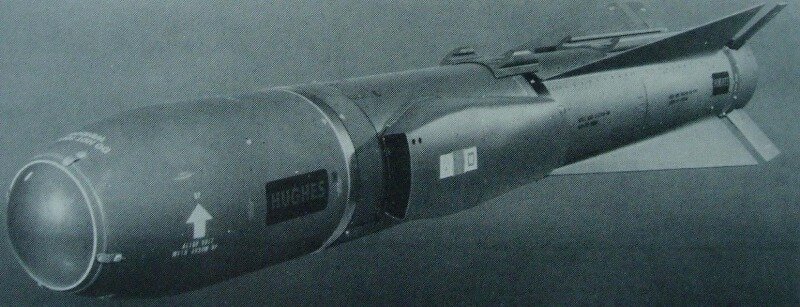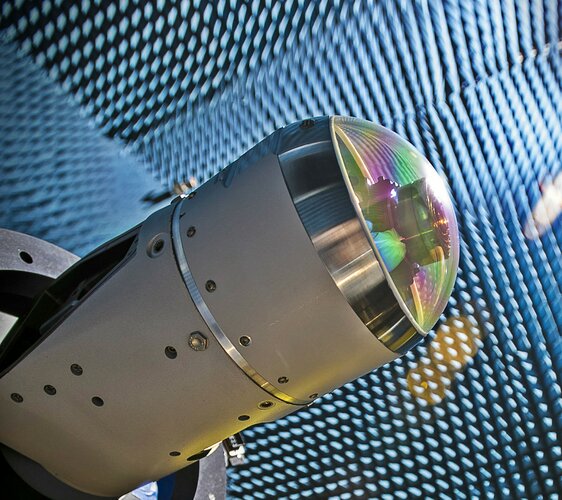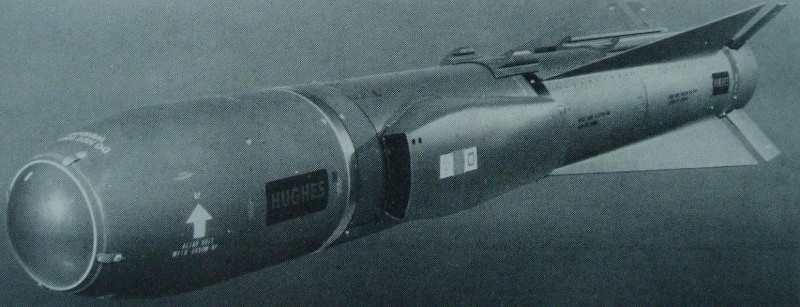- Joined
- 18 May 2019
- Messages
- 640
- Reaction score
- 1,673
The dual mode AGM-65D Maverick anti-radar guided missile
Hughes Aircraft Corporation in the United States has built three unites of the Maverick anti-radar guided missile equipped with a dual mode passive radar/television target seeking head. It was designed especially to strike at radar control towers. The special characteristic of this guided missile is that even after enemy radar has locked in on the aircraft, it can still be used in a preventive function.
When the Maverick anti-radar guided missile with dual mode target seeking head was test launched from F-4 Phantom aircraft, in the first trial the anti-radar component in the target seeking head gauged the course of a radiating target. Later in second stage of trials the missile automatically switched to the telesision target seeking head modality.
here is an error, AGM-65D have infrared target acquisition, not television
Longhorn Maverick
In December 1991, came in the company Hughes project missiles AGM-65 Maverick with extended-range at 74 km (40 nm). The shot should be based on the version of the AGM-65F with the fuselage extended by about 90 cm for a total of 3.35 m. was Planning to make a version using the INFRARED homing system, the second variant was to use radar guidance.
Longhorn does not exceed the stage of the project.

MILLIMETER WAVE SEEKER DEMONSTRATION (MMW)
Operational Utility of MMW
Autonomous Current air launched standoff precision guided weapons require a man in the loop during standoff weapon weapons flight to ensure effectiveness. The purpose of this effort is to demonstrate the application of millimeter wave seeker technology to standoff air-to-ground weapons. This project will provide the Air Force with a candidate day/night, adverse weather, autonomous, lock-on-after-launch weapon for standoff delivery against fixed and mobile airdefense units, moving and massed armor, and other mobile battlefield and second echelon targets. This project will integrate MMW seekers on AGM-65 Maverick airframes for flight testing through a competitive demonstration program.
Technical Approach of MMW Demonstrate
The technical goals to be achieved in this project include:
Demonstrate MMW seeker maturity and readiness for full-scale engineering development
Demonstrate the ability of the seeker to locate targets in clutter and discriminate targets by type
Assess seeker susceptibility to countermeasures
Integrate a MMW seeker with the Maverick center and aft sections
Obtain multiple launches and kills per aircraft pass
Unit production cost to be less than $110,000 (FY 1987 dollars for 10,000 units. )
There are several key technical issues to be addressed by this effort. They include development and demonstration of algorithms to enable the seeker to discriminate airdefense units from other targets, to reduce the number of false alarms, to operate in a countermeasures environment, and to terminally track and hit targets. Integration of the
MMW seeker with the Maverick airframe to permit impact at less than normal speed is alsoa technical challenge. MMW Progress to Date Both of the contractors in this Congressional Special Interest program have tested Captive carrybrassboard seekers. Both seekers performed well in captive flight tests flown against tests successful realistic target arrays including the SA-6 air defense system simulator and a variety of tanksand other armored vehicles. Tests were conducted in both low clutter and high clutter environments. These seekers work especially well against moving vehicles and rotating antennas.
The MMW seeker easily detected and tracked the target air defense unit. Movingtargets are easily detected because of the moving-target-indicator design. The also workagainst arrays of stationary vehicles, but less capability is available with stationary targets. Hardware fabrication and software refinement continued in support of planned free flightmissile tests. Hardware-in-the-loop testing continued. Special targets have been fabricated for the captive carry tests and planned missile launches. MMW Planned Activity High speed captive carry and free flight testing will be conducted in FY 1991. The MMW Free flight testing Maverick program demonstration should be completed in early FY 1992 with FY 1991 planned funds. The operative Program Management Directive requires a Milestone 11 decision in FY 1993 and subsequent start of FSD. TAC is considering whether MMW Maverick will fulfill the need for an Advanced Attack Weapon under the terms of the approved Statementof Need 317-87.
Hughes Aircraft Corporation in the United States has built three unites of the Maverick anti-radar guided missile equipped with a dual mode passive radar/television target seeking head. It was designed especially to strike at radar control towers. The special characteristic of this guided missile is that even after enemy radar has locked in on the aircraft, it can still be used in a preventive function.
When the Maverick anti-radar guided missile with dual mode target seeking head was test launched from F-4 Phantom aircraft, in the first trial the anti-radar component in the target seeking head gauged the course of a radiating target. Later in second stage of trials the missile automatically switched to the telesision target seeking head modality.
here is an error, AGM-65D have infrared target acquisition, not television
Longhorn Maverick
In December 1991, came in the company Hughes project missiles AGM-65 Maverick with extended-range at 74 km (40 nm). The shot should be based on the version of the AGM-65F with the fuselage extended by about 90 cm for a total of 3.35 m. was Planning to make a version using the INFRARED homing system, the second variant was to use radar guidance.
Longhorn does not exceed the stage of the project.

MILLIMETER WAVE SEEKER DEMONSTRATION (MMW)
Operational Utility of MMW
Autonomous Current air launched standoff precision guided weapons require a man in the loop during standoff weapon weapons flight to ensure effectiveness. The purpose of this effort is to demonstrate the application of millimeter wave seeker technology to standoff air-to-ground weapons. This project will provide the Air Force with a candidate day/night, adverse weather, autonomous, lock-on-after-launch weapon for standoff delivery against fixed and mobile airdefense units, moving and massed armor, and other mobile battlefield and second echelon targets. This project will integrate MMW seekers on AGM-65 Maverick airframes for flight testing through a competitive demonstration program.
Technical Approach of MMW Demonstrate
The technical goals to be achieved in this project include:
Demonstrate MMW seeker maturity and readiness for full-scale engineering development
Demonstrate the ability of the seeker to locate targets in clutter and discriminate targets by type
Assess seeker susceptibility to countermeasures
Integrate a MMW seeker with the Maverick center and aft sections
Obtain multiple launches and kills per aircraft pass
Unit production cost to be less than $110,000 (FY 1987 dollars for 10,000 units. )
There are several key technical issues to be addressed by this effort. They include development and demonstration of algorithms to enable the seeker to discriminate airdefense units from other targets, to reduce the number of false alarms, to operate in a countermeasures environment, and to terminally track and hit targets. Integration of the
MMW seeker with the Maverick airframe to permit impact at less than normal speed is alsoa technical challenge. MMW Progress to Date Both of the contractors in this Congressional Special Interest program have tested Captive carrybrassboard seekers. Both seekers performed well in captive flight tests flown against tests successful realistic target arrays including the SA-6 air defense system simulator and a variety of tanksand other armored vehicles. Tests were conducted in both low clutter and high clutter environments. These seekers work especially well against moving vehicles and rotating antennas.
The MMW seeker easily detected and tracked the target air defense unit. Movingtargets are easily detected because of the moving-target-indicator design. The also workagainst arrays of stationary vehicles, but less capability is available with stationary targets. Hardware fabrication and software refinement continued in support of planned free flightmissile tests. Hardware-in-the-loop testing continued. Special targets have been fabricated for the captive carry tests and planned missile launches. MMW Planned Activity High speed captive carry and free flight testing will be conducted in FY 1991. The MMW Free flight testing Maverick program demonstration should be completed in early FY 1992 with FY 1991 planned funds. The operative Program Management Directive requires a Milestone 11 decision in FY 1993 and subsequent start of FSD. TAC is considering whether MMW Maverick will fulfill the need for an Advanced Attack Weapon under the terms of the approved Statementof Need 317-87.
Last edited:


